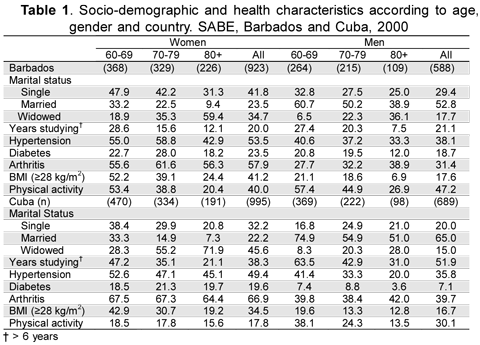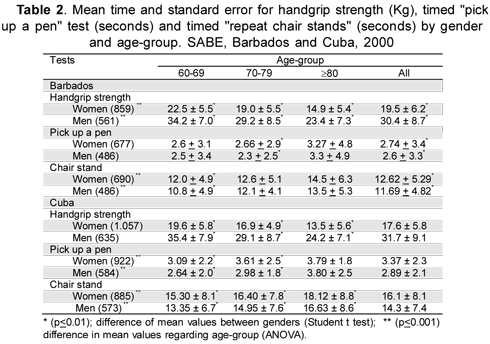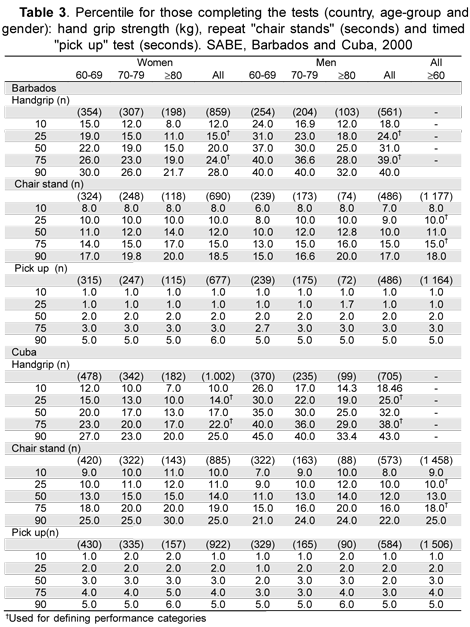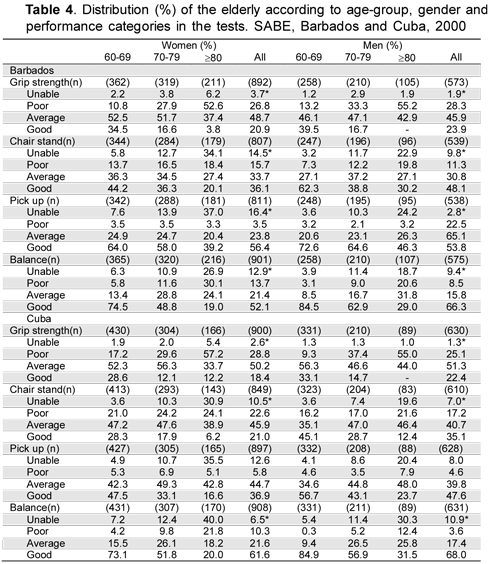Servicios Personalizados
Revista
Articulo
Indicadores
-
 Citado por SciELO
Citado por SciELO -
 Accesos
Accesos
Links relacionados
-
 Citado por Google
Citado por Google -
 Similares en
SciELO
Similares en
SciELO -
 Similares en Google
Similares en Google
Compartir
Revista de Salud Pública
versión impresa ISSN 0124-0064
Rev. salud pública v.13 n.1 Bogotá ene./feb. 2011
Age and gender differences regarding physical performance in the elderly from Barbados and Cuba
Diferencias por edad y sexo en el desempeño físico de ancianos de Barbados y Cuba
Aline Rodrigues-Barbosa1, Leticia Miranda de Miranda2, Alexsander Vieira-Guimarães2, Herton Xavier-Corseuil2, and Marui Weber-Corseuil3
1 Programa de Pós Graduação em Educação Física, Programa de Pós-Graduação em Nutrição. Departamento de Educação Física, Centro de Desportos, Universidade Federal de Santa Catarina. Florianópolis-SC. Brasil. alinerb@cds.ufsc.br, alinerb13@yahoo.com.br
2 Departamento de Educação Física, Centro de Desportos. Universidade Federal de Santa Catarina. Florianópolis-SC. Brasil
3 Centro de Ciências da Saúde, Departamento de Saúde Pública. Universidade Federal de Santa Catarina. Florianópolis-SC. Brasil
Received 11th May 2010/Sent for Modification 20th December 2010/Accepted 18th January 2011
ABSTRACT
Objective Presenting physical performance tests' (PPTs) descriptive reference values and prevalence according to gender and age-group regarding a representative sample of non-institutionalised older adults (aged 60 and over) living in Bridgetown (Barbados) and Havana (Cuba).
Methods This was a cross-sectional, population-based household survey. In Bridgetown and Havana, respectively, 1,508 and 1,905 subjects were examined who had been selected by probabilistic sampling. PPTs included handgrip strength, standing balance, timed repeated "chair stand" and "pick up a pen."
Results The results from Bridgetown and Havana showed that values (mean ± standard deviations and percentiles) for men were greater than women in handgrip strength and "chair stand" tests (p≤0.01). Increasing age led to both genders having reduced (p≤0.001) prevalence of people having better results for each test (based on chi-square). Men had proportionately better scores than women in the four tests.
Conclusion The data suggested that younger people and men had better physical performance. Men and women in both countries had differences regarding the prevalence of people unable to perform the tests and better test results, according to the test and age-group. The data provided information about the range of performance that can be expected from people in different ages and helped understand usual rates of change in age-groups.
Key Words: Aging, cross-sectional study, hand strength, time and motion study (source: MeSH, NLM).
RESUMEN
Objetivo Presentar valores de referencia y la prevalencia del desempeño en pruebas físicas (PPTs), de acuerdo con el sexo y la edad de una muestra de ancianos no institucionalizados (60 años y más) residentes en Bridgetown (Barbados) y La Habana (Cuba).
Métodos Estudio transversal de base poblacional y domicilio. Se examinaron 1 508 y 1 905 individuos en Bridgetown y La Habana, respectivamente, seleccionados por medio de una muestra probabilistica. Los PPTs incluían fuerza de la mano (FM), equilibrio, y las pruebas "sentar y levantar" (SL) y "coger el lápiz" (PL), repetidas en el tiempo.
Resultados Los resultados de Bridgetown y La Habana mostraron: a. Los valores (media ± desviación estándar y percentiles) de los hombres fueron mayores que los de las mujeres en las pruebas de FM y SL (p=0,01); b. Con el avance de la edad, ambos sexos mostraron reducción (p=0,001) en la prevalencia de individuos con mejor resultado de cada prueba (ji-cuadrado); c. Los hombres presentaron mejores puntajes que las mujeres en las cuatro pruebas.
Conclusión Los dados sugieren que los hombres y los individuos más jóvenes tienen mejor desempeño físico. Hombres y mujeres de los dos países, de acuerdo con la prueba y grupo de edad, presentan diferencia en la prevalencia de individuos incapaces y con mejores resultados en las pruebas. Los dados suministran información sobre la variabilidad que puede ser esperada, del desempeño de individuos de diferentes edades y auxilian en la comprensión de tasas de alteración entre los grupos de edad.
Palabras Clave: Envejecimiento, estudios transversales, fuerza de la mano, estudios de tiempo y movimiento (fuente: DeCS, BIREME).
RESUMO
Objetivo Apresentar valores de referência e a prevalência do desempenho em testes físicos (PPTs), de acordo com sexo e grupo etário, de uma amostra de idosos não institucionalizados (60 anos e mais) residentes em Bridgetown (Barbados) e Havana (Cuba).
Métodos Trata-se de estudo transversal de base populacional e domiciliar. Foram examinados 1 508 e 1 905 indivíduos em Bridgetown e Havana, respectivamente, selecionados por amostra probabilística. Os PPTs incluiram força de preensão manual (FPM), equilíbrio, e os testes "sentar e levantar" (SL) e "pegar o lápis" (PL), avaliados por tempo.
Resultados Os resultados de Bridgetown e Havana mostraram: a) valores (media ± desvio padrão e percentis) dos homens foram maiores do que os das mulheres nos testes de FPM e SL (p≤0,01); b) com o avanço da idade, ambos os sexos mostraram redução (p≤ 0,001) na prevalência de indivíduos com melhor resultado em cada teste (teste qui-quadrado); c) os homens apresentaram melhores escores do que as mulheres nos quatro testes.
Conclusão Os dados sugerem que os homens e os indivíduos mais jovens têm melhor desempenho físico. Homens e mulheres dos dois países, de acordo com o teste e grupo etário, apresentam diferença na prevalência de indivíduos incapazes e com melhores resultados nos testes. Os dados fornecem informação sobre a variabilidade que pode ser esperada, do desempenho de indivíduos de diferentes idades e auxiliam na compreensão de taxas de alteração entre os grupos etários.
Palavras chave: Envelhecimento, estudos transversais, força da mão, estudos de tempo e movimento (fonte: DeCS, BIREME).
People's aging in Barbados and Cuba has progressed more and at speeds which are more comparable to processes experienced by industrialised regions (1). Such fast population aging implies new challenges concerning health. The matter is not longevity alone, but also how elderly people will live (2). Every aging person wishes to maintain the ability to fulfil their daily tasks independently and self-reliantly (3-7).
Physical performance tests (PPT) (considered objective measurements) can offer advantages when compared to indirect evaluations (perception) in assessing elderly people's functional limitation in terms of validity, reproducibility, less cultural and educational influence, as well as in the ability to identify high levels of physical fitness and their applicability in population studies. PPTs can also provide preliminary information on elderly health regarding a disability's risk and progression, establishing the target population subgroup for intervention programmes and preventing functional limitation (8,9).
There is still a lack of information regarding elderly people's health conditions in Barbados and Cuba and no studies using PPTs for functional evaluation of the elderly have been found in the literature. This study presents descriptive reference values and prevalence (according to gender and age-group) from evaluating physical performance by assessing strength, mobility and balance. The sample consisted of non-institutionalised elderly people examined in Bridgetown and Havana.
METHODS
Data from Barbados and Cuba were extracted from the "Survey on Health, Aging and Well Being in Latin America and the Caribbean" (SABE) (10), a multicentre study coordinated by the Pan-American Health Organisation (PAHO) conducted in 7 countries (Argentina, Brazil, Chile, Cuba, Mexico, Uruguay and Barbados) during 1999-2000. The SABE protocol was approved by ethical committees from universities in each participating country and the PAHO Ethics Review Committee (PAHOERC) (1).
The study population consisted of people aged 60 and older (men and women), residing in the cities of Bridgetown (1,508 subjects) and Havana (1,905 subjects). SABE sampling procedures have been reported elsewhere (1,10,11).
Assisted interviews were conducted for 3.9% of the interviews in Bridgetown, and 9.2 % in Havana. Sample losses associated with physical measurements in Barbados and Cuba were 18.0% and 19.1%, respectively (1).
Physical performance tests (PPTs)
PPTs were administered in a home setting with limited unobstructed space. The dimensions assessed by the PPTs included: upper body strength, lower body strength, mobility/flexibility and balance. Test procedures have been previously described (5) and will now be presented concisely.
Handgrip strength. The test was taken using the arm considered dominant by the subject. Number (kg) distribution was made in percentiles, according to gender, to evaluate performance on this test. They were classified according to the following score: score 0=unable; score 1 (poor)≤ 25th ; >25th to ≤75th (average)=score 2; score 3 (very good)≥75th.
Chair stands. This consisted of time taken in seconds to rise five times from an armless chair (with crossed arms); this test was considered to be successfully accomplished when completed in ≤60 seconds. Quartiles for the length of time required were used for scoring. Performance categories were created to allow analysis that included those unable to perform the task, as follows: >60 seconds, score 0 (unable); ≤25th score 1 (poor); >25th to ≤75th score 2 (average); >75th score 3 (very good).
Pick up a pen (12). This consisted of the time taken in seconds (? 30 seconds) to bend down and pick up a pen from the floor. The classification used for this test was taken from Barbosa et al., (6), adapted from Reubem (12), with a four-point scale [0-3] and included those unable to perform the task, as follows: >30 seconds, score 0 (unable); >6 to ≤30 seconds, score 1 (poor); >2 to ≤6 seconds, score 2 (average); ≤2 seconds, score 3 (very good).
Balance. This was determined by four separate measurements. The subject was asked to perform each of the following tasks for 10 seconds: 1. side-by-side stand, full tandem stand, one-leg stand (right) and one-leg stand (left). The classification used for this test was taken from Barbosa et al., (5).
Individuals who refused to take the tests or were unable to understand the instructions due to cognitive problems were excluded from the analysis. People unable to perform the manoeuvres because of physical limitations were included in the data; those who could not walk or needed help to keep standing, had paralysis in any extremity, had a prosthesis on either leg, or could not keep their balance did not take the tests related to the lower limbs; those who had undergone eye surgery during the previous six weeks did not take the "pick up a pen" test; people who had undergone arm or hand surgery in the three months prior to data collection did not take the handgrip strength test. The interviewers explained and demonstrated the task before each test and made sure that the task could be completed without any physical risk to the subject.
Socio-demographic and health characteristics
Marital status (single, married, widowed), education (≤6 years;>6 years), physical activity (yes; no) (i.e. participants were asked whether they had exercised or participated in vigorous physical activity three or more times a week during the past 12 months), body mass index (BMI<28 and≥28 kg/m2) (13) were calculated with weight and height values. The prevalence (yes, no) of previously diagnosed illnesses was assessed via a series of questions asking the respondents if they had been told by a doctor/nurse that they had hypertension, diabetes and arthritis.
Statistical procedure
Means, standard deviations and percentiles (10th, 25th, 50th, 75th and 90th) were used in accordance with gender and age-group (60-69, 70-79, ≥80 years) for data analysis. Differences between means were determined by Student's t-test (p≤0.05) for comparing genders; the effect of age-group was assessed by ANOVA (p≤0.05). Cross-tabulation with X2 test (p≤0.05) was used to verify the percentage of those unable to perform a particular test and having poor, average and very good performances in each test, by gender and age-group. Weighting was applied to all analysis to account for the sampling design. SPSS 11.5 (SPSS, Inc., Chicago, IL, USA) was used for all statistical analysis.
RESULTS
Barbadians' mean age (± standard deviation) was 71.8 ± 7.9 (range 60-95 years) for males and 73.0 ± 8.7 years for females (range 60-97). Cuban males' mean age was 70.2 ± 8.0 (range 60 to 96 years) and 71.6 ± 8.7 years (range 60-102) for females.
Table 1 presents the overall characteristics for people from each country. The percentage of chronic diseases, obesity and physical inactivity was greater in both countries among women and less prevalent in the oldest age-group (≥ 80 years). Higher educational levels were more prevalent in men.

Men from all age-groups (Barbadians and Cubans) presented greater values than women in handgrip strength (p<0.01). Mean time (±SD) for "chair stand "and "pick up" completion was greater for women and the oldest age-groups (p<0.01), except for the ≥80 year-old age-group, in the "pick up" test, in which there was no difference in mean times for men and women from both countries (Table 2).

Data from Table 3 shows that the values used for handgrip strength and "chair stand" test performance categorisation (25th and 75th percentiles) were lower amongst Cuban females compared to Barbadian women. Values for the 25th and 75th percentiles were greater amongst men from Barbados and Cuba, respectively. With the exception of men in the 60-69 year-old age-group, Cubans generally had greater median values than Barbadians in the "pick up a pen" test.

Table 4 shows the distribution of scores for the four performance-related categories in each test. Both genders showed a reduction (p≤0.001) in the percentage of people having better results for each test with increasing age. The percentage of people who were physically unable to perform the tasks increased with age, except for the handgrip strength test, in which a greater percentage of men in the 70-79 age-group from both countries were classified as being unable. Men (in all age-groups) had proportionately better scores than women in the four tests.

DISCUSSION
This is the first household-based population study with elderly people from Barbados and Cuba to present gender- and age-group-specific reference values in physical performance tests. Although the research data was collected in 2000, no research having similar characteristics to the SABE Barbados and Cuba survey has been carried out, which means that this data is the most current.
Timing tests results showed that Cubans (men and women) had better outcomes while handgrip strength was better among Barbadians (both men and women). Mean and median values for the handgrip strength, pick up a pen and chair stand tests were quite close in nearly all age-groups. Barbadian men (60-69 years) and Cuban women (all age-groups) had median values respectively greater and lower than mean values in the handgrip strength and chair stand tests, indicating that the distribution was skewed and mean times were influenced by extreme values.
When compared to data from São Paulo/Brazil (5), which involved 1,894 people (≥ 60 years), the cut-off points for handgrip strength (25th and 75th percentiles) in Cuban women were lower than in Brazilians, while values were greater for men. Barbadian men and women had the same value for the 25th percentile as the Brazilian elderly, and greater values in the 75th percentile.
Mean handgrip strength values in women from São Paulo, Brazil, (5) were greater than Cubans and similar to Barbadians in all age-groups. Men from the three countries had close mean handgrip strength values in all age-groups. Mean time (seconds) for carrying out the "pick up a pen" and "chair stand" tests showed that Cubans had worse performance and Barbadians performed similarly compared to people from São Paulo, Brazil (5).
The results showed that a relatively consistent pattern determined the increased time taken to perform the tests, as well as the decrease in handgrip strength in women and older age-groups. The percentage of better-performing people decreased in all tests with increasing age, most noticeably in the oldest age-group (80 years) in both countries. Such findings agreed with what has been observed by other researchers in tests related to lower (3-5) and upper limb ability (5,14-16).
The prevalence of people having better results was specific to each test and also varied considerably between gender and according to age-group in both countries. The balance test had the highest percentage of men and women rated very good in all age-groups in Cuba; the same was observed in Barbadian men and women (60-69 years). The "pick up a pen" test had the highest percentage of men and women having a very good score in Brazil (5) in all age-groups.
The elderly rated as being unable had a very test-specific percentage: 40.0 % (balance test) and 35.5 % ("pick up a pen" test), respectively, for Barbados and Cuba among 80-year and older women. The highest frequency for unable people in Brazil was 14.0 % for 80-year and older people in the "chair stand" test. Data from the Third National Health and Nutrition Examination Survey (4) has shown that 5.6 % and 9 % of men and women, respectively, were physically unable to perform the "chair stand" test. Such data has suggested that the prevalence of physical inability for this test was greater among Barbadians (9.8 % for men and 14.8 % for women).
Such variations between elderly people from different countries concerning strength (kg), time (seconds) and inability may have been a consequence of the number of people participating in the different age-groups, better individual ability, ethnic differences, nutritional status, physical activity, working conditions throughout their lives and/or occurrence of disease which were not assessed in this study. Obesity, for instance, was more frequent in Barbados compared to observed prevalence in Cuba and Brazil (11,13,17) which could have justified the better results in the handgrip strength test and the worse times (compared to Brazil) in tests demanding bodily support, similar to time-evaluated tests. On the other hand, arthritis (a factor hampering mobility) and physical inactivity were most frequent in Cubans, thereby explaining their poor performance.
Decreased performance was to be expected as a consequence of aging, involving physiological changes and reduced physical and functional ability. However, the degree and speed of such alterations differed and seemed to be caused by inherited characteristics, environmental influences throughout life, mental health and self-rated health (18).
Differences in physical ability between men and women are well known. Several studies have identified being female as an independent risk factor for functional decrease; as women have greater life-expectancy, they may be subject to more or to different chronic diseases, thereby resulting in functional limitations (4, 18) and differences in nutrition status (13 -17) and prevalence of physical inactivity (19). The results from this study showed that women from both countries had a greater prevalence for obesity, hypertension, diabetes, arthritis, physical inactivity and lower educational level.
It is worth noticing that even though Barbados and Cuba are countries having advanced aging, demographic and epidemiological transition are quite heterogeneous, also due to political and social differences between the two countries. Results thus reinforce the idea that comparing limitations between different populations should be seen with caution. There is usually a decrease in motor performance with increasing age and better performance in men. Such characteristics may be universal, but their prevalence and the way they occur can vary among and between groups of elderly people, whether genetically similar or not, as a result of the action of environmental and behavioural factors on normal aging effects.
This study presented the limitations inherent in cross-sectional studies and did not permit individual changes in physical performance to be assessed. Other limitations included eligible examinees missing the PPTs, especially in Cuba, which may have affected statistical means and prevalence.
The data provided information about the range of performance which could be expected of people at different ages, help understand usual rates of change across age-groups and also allow the subjects' performance to be compared with that of others having the same age and gender (12), both in medical practice and epidemiological studies. Since men and women in both countries had differences in the prevalence of people unable to perform the tests and better test results, according to the test and age-group, intervention proposals must take gender and age-groups into consideration and also emphasise different aspects of fitness in improving functional performance.
Acknowledgments: The SABE survey in Barbados was funded by the Caribbean Development Bank, the Pan-American Health Organisation, the Chronic Disease Research Centre Appeal Fund and the Caribbean Health Research Council. It was partially funded in Cuba by the National Institute of Statistics' Population Centre and Ministry of Health. The authors would also like to thank the elderly people who took part in the SABE survey.
REFERENCES
1. Albala C, Lebrão ML, León-Díaz EM, Ham-Chande R, Hennis AJ, Palloni A, et al. Encuesta Salud, Bienestar y Envejecimiento (SABE): metodología de la encuesta y perfil de la población estudiada. Rev Panam Salud Publica/Pan Am J Public Health. 2005; 17: 307-22. [ Links ]
2. Rodriguez-Cabrera A, Alvarez-Vazquez L. Repercusiones del envejecimiento de la población cubana en el sector salud. Rev Cubana Salud Pública. 2006; 32, 178-82. [ Links ]
3. Guralnick JM, Ferrucci L, Simonsick EM, Salive ME, Wallace RB. Lower-extremity function in persons over age of 70 years as a predictor of subsequent disability. New Engl J Med. 1995; 332(9): 556-61. [ Links ]
4. Ostchega Y, Harris TB, Hirsch R, Parsons VL, Kington R, Katzoff M. Reliability and prevalence of physical performance examination assessing mobility and balance in older persons in the US: data from the third National and Nutrition Examination Survey. J Am Geriatr Soc. 2000; 48:1136-41. [ Links ]
5. Barbosa AR, Souza JMP, Lebrão ML, Marucci MFN. Functional limitations of Brazilian elderly by age and gender differences: data from SABE Survey. Cad. Saúde Pública. 2005; 21:1177-1185. [ Links ]
6. Maciel ACC, Guerra RO. Functional limitation and survival of community dwelling elderly. Rev Assoc Med Bras. 2008; 54: 347-352. [ Links ]
7. Markides KS, Black SA, Ostir GV, Angel RJ, Guralnik JM, Lichtenstein M. Lower body function and mortality in Mexican American elderly people. J Gerontol A Biol Sci Med Sci. 2001; 56A:M243-7. [ Links ]
8. Moore DJ, Moseley S, Palmer BW. The clinical usefulness of performance-based assessments of daily functioning for older adults. Geriatrics. 2008; 63: 16-20. [ Links ]
9. Guralnik JM, Ferruci L, Pieper CF, Leveille SG, Markides KS, Ostir GV et al. Lower Extremity Function and Subsequent Disability: Consistency Across Studies, Predictive Models, and Value of Gait Speed Alone Compared With the Short Physical Performance Battery. J Gerontol A Biol Sci Med Sci. 2000; 55A: M221-31. [ Links ]
10. Peláez M, Palloni A, Albala C, Alfonso JC, Ham-Chande R, Hennis A et al. SABE - Survey on Health, Welfare, and Aging, 2000 [electronic file]: Pan American Health Organization (PAHO/WHO) [producer and distributor], 2004. Ann Arbor, MI: Inter-university Consortium for Political and Social Research [distributor]; 2005. [ Links ]
11. Wong R, Palloni A, Peláez M, Markides K. Survey data for the study of aging in Latin America and the Caribbean: selected studies. J Aging Health. 2006; 18: 157-79. [ Links ]
12. Reuben DB, Siu AL. An objective measure of physical function of elderly outpatients -The Physical Performance Test. J Am Geriatr Soc. 1990; 38:1105-12. [ Links ]
13. Troiano RP, Grongiollo EA Jr, Sobal J, Levitsky DA. The relation between body weight and mortality: a quantitative analysis of combined information from existing studies. Int J Obes Relat Metab Disord. 1996; 20(1): 63-75. [ Links ]
14. Barbosa AR, Souza JMP, Lebrão ML, Marucci MFN. Nutritional status and physical performance of elderly in the city of São Paulo. Rev Assoc Med Bras. 2007; 53:75-9. [ Links ]
15. Al Snih S, Markides KS, Ray L, Ostir GV, Goodwin JS. Handgrip strength and mortality in older Mexican Americans. J Am Geriatr Soc. 2002; 50: 1250-56. [ Links ]
16. Sternfeld B, Ngo L, Satariano WA, Tager IB. Associations of body composition with physical performance and self-reported functional limitation in elderly men and women. Am J Epidemiol. 2002; 156: 110-21. [ Links ]
17. Coqueiro RS, Barbosa AR, Borgatto AF. Anthropometric measurements in the elderly of Havana, Cuba: Age and sex differences. Nutrition. 2009; 25: 33-39. [ Links ]
18. Sergi G, Perissinotto E, Pisent C, Buja A, Maggi S, Coin A. Lower extremity motor performance and body mass index in elderly people: The Italian Longitudinal Study on Aging. J Am Geriatr Soc. 2007; 55: 2023-29. [ Links ]
19. Barreto SM, Passos VMA, Lima-Costa MFF. Obesity and underweight among Brazilian elderly. The Bambuí Health and Aging Study. Cad Saude Publica. 2003; 19:605-12. [ Links ]














